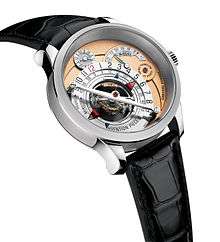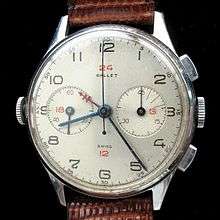Complication (horology)
In horology, a complication refers to any feature in a mechanical timepiece beyond the simple display of hours and minutes. A timepiece indicating only hours and minutes is otherwise known as a simple movement. Common complications in commercial watches are day/date displays, alarms, chronographs (stopwatches), and automatic winding mechanisms.
The more complications in a mechanical watch, the more difficult it is to design, create, assemble, and repair. These stipulations do not apply or refer to quartz watches. A typical date-display chronograph may have up to 250 parts, while a particularly complex watch may have a thousand or more parts. Watches with several complications are referred to as grandes complications.
The initial ultra-complicated watches appeared due to watchmakers' ambitious attempts to unite a great number of functions in a case of a single timepiece. The mechanical clocks with a wide range of functions, including astronomical indications, suggested ideas to the developers of the first pocket watches. As a result, as early as in the 16th century, the horology world witnessed the appearance of numerous complicated and even ultra-complicated watches.
Ultra-complicated watches are produced in strictly limited numbers, with some built as unique instruments. Some watchmaking companies known for making ultra-complicated watches are Breguet, Patek Philippe, and Vacheron Constantin.[1]


Grand complications
A grand complication is a watch with several complications, the most complex achievements of haute horlogerie, or fine watchmaking. Although there is no 'official' definition,[2] one common definition is a watch that contains at least three complications, with at least one coming from each of the groups listed below:[3]
| Timing complications | Astronomical complications | Striking complications |
|---|---|---|
| Simple chronograph | Simple calendar | Alarm |
| Counter chronograph | Annual calendar | Quarter repeater |
| Split-second flyback chronograph | Perpetual calendar | Half-quarter repeater |
| Independent second-hand chronograph | Equation of time | Five-minute repeater |
| Jumping second-hand chronograph | Moon phases | Minute repeater |
The most complicated pocket watch movements
According to watch manufacturer Patek Philippe, the three most complicated watches in the world are all pocket watches made by that company.
- The Patek Philippe Calibre 89 has 33 complications, using a total of 1728 parts. It was released in 1989 to commemorate the 150th anniversary of the company.[4] The complications include the date of Easter, sidereal time, and a 2800-star celestial chart.
- The Supercomplication delivered to Henry Graves, Jr. in 1933 has 24 complications. The watch was reportedly the culmination of a watch arms race between Graves and James Ward Packard. The Super-complication took three years to design and five to build, and sports a chart of the nighttime sky at Graves' home in New York. This was the world's most expensive watch when it was auctioned off for US$11 million in 1999.[5] It remains the most complicated watch (920 parts)[6] built without the assistance of computers.[7] In November 2014 it was auctioned again, selling for 23.2 million Swiss francs (US$24 million) and setting a new timepiece auction record.[6]
- The Star Caliber 2000 has 21 complications. They include sunrise and sunset times and the lunar orbit, and it is capable of playing the melody of Westminster quarters (from the clock tower of the Houses of Parliament in London).
The Vacheron Constantin Reference 57260 is now widely regarded as the most complicated watch in the world. It is a mechanical pocket watch which features 57 complications, introduced by Vacheron Constantin in 2015. The company claims that it is the most complicated mechanical pocket watch ever created. The Reference 57260 took eight years to assemble, and has 2826 parts and 31 hands. It weighs 957 grams, and spans 98mm.
The most complicated wristwatch movement
The Franck Muller Aeternitas Mega 4 is the world's most complicated wristwatch. It has 36 complications, 25 of them visible, 1483 components and 1000-year calendar.[8]
The Hybris Mechanica Grande Sonnerie is the world's second most complicated wristwatch. Powered by the Jaeger LeCoultre Calibre 182 movement, with 27 complications and over 1300 parts. The movement is housed in a 44mm by 15mm 18k white gold case.[9]
Examples
Examples of complications include:
|
|
Nonhorological complications
Sometimes various displays in or on a watch are counted as complications even if they have nothing to do with timetelling. Often-seen examples include thermometer, barometer (rare in watches; more frequent in clocks), compass, or altimeter. Many horologists will not count nonhorological complications when adding up the number of complications on a given watch or clock, and some purists even exclude the power reserve from the complications count because it does not show a time indication (although its function is related to timekeeping).
References
- ↑ Ultra-complicated watches
- ↑ Perez, Carlos (June 10, 2001). "Of the Blood Royal". Carlos' Journal. TimeZone.com. Retrieved 2008-04-20.
- ↑ Nicolet, J.C. (1999). "What does the term 'complication' mean, and how does it differ from 'grand complication'?". Questions in Time. Europa Star magazine online. Retrieved 2008-07-09.
- ↑ Watches - Switzerland - Information - swissworld.org, Federal Department of Foreign Affairs, General Secretariat, Presence Switzerland.
- ↑ http://most-expensive.net/watches
- 1 2 Mulier, Thomas; Pulvirent, Stephen (November 12, 2014). "Most Expensive Watch: Patek Philippe Supercomplication Sets Record at $24 Million". Bloomberg.com. Retrieved November 12, 2014.
- ↑ "The story of the 'most complicated' watch in the world". BBC News. November 11, 2014.
- ↑ "World's Most Complicated Wristwatch: Franck Muller Aeternitas Mega 4". January 11, 2010.
- ↑ "Jaeger-LeCoultre: Hybris Mechanica à Grande Sonnerie". June 19, 2009.
External links
- Perez, Carlos (June 10, 2001). "Of the Blood Royal". Carlos' Journal. TimeZone.com. Retrieved 2008-04-20.